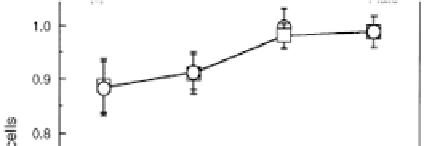Biomedical Engineering Reference
In-Depth Information
fatigue, and cytocompatibility. The Ti-15Zr-4Nb-4Ta-0.2Pd-
0.2O-0.05N alloy exhibited a higher corrosion resistance in
physiological saline solution. The addition of 0.02% O and 0.05%
N to Ti-Zr-type alloy improved the mechanical properties at room
temperature and corrosion fatigue strength [36]. The comparison of
various Ti-alloys on the relative growth ratio of L929 and MC3T3-
E1 cells is shown in Fig. 5.8. The relative growth ratio of L929
and MC3T3-E1 cells for the Ti-Zr and Ti-Sn-type alloys are nearly
equal to 1 and are slightly higher than those of pure Ti grade 2 and
Ti
-
6Al-4V alloy. The effect of the metallic ions released from these
alloys on the relative growth ratios of L929 and MC3T3-E1 cells is
shown too (Fig. 5.8b). The relative growth ratios are similar to those
of the alloys for both L929 and MC3T3-E1 cells [36].
Figure 5.8
Cytocompatibility on the various Ti alloy plates (a) and
cytocompatibility of alloy blocks extraction with Eagle's MEM
for L929 cells and ultra pure water for MC3T3-E1 cells (b)
[36].





















